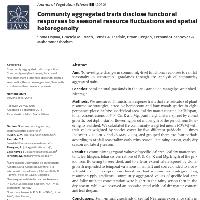Resumen
- Aim: To investigate changes in community‐level functional responses to rainfall seasonality in Neotropical grasslands through the analysis of community aggregated traits. Location: Semi‐natural grasslands in the Río Grande de Matagalpa watershed, Nicaragua. Methods: We measured 14 functional response traits that are indicators of plant resource‐use strategies, across 32 herbaceous and four woody species in eight permanent plots: leaf size, specific leaf area, leaf dry matter content, leaf lifespan, foliar concentrations of P, N, Ca, K and Mg, plant height, lateral spread by clonal growth, root depth, start of flowering period and length of the period from flowering to seed shed. We calculated the community‐weighted means (CWM) with trait values weighted by species cover for five different paddocks 11 times (between 2 Jul 2007 and 26 May 2008), and grouped them into four periods according to rainfall seasonality: early rainy season, late rainy season, early dry season and late dry season. Results: ommunity aggregated values of specific leaf area, leaf dry matter content, leaf lifespan, foliar concentrations of P, N, Ca, K and Mg, length of the period from flowering to seed shed, and to a lesser extent lateral spread by clonal growth responded to temporal variations in rainfall, and corresponded to a considerable extent to expectations based on plant resource‐use strategies along resource supply gradients. Community aggregated values of specific leaf area and foliar nutrient concentration were higher in the rainy season than in the dry season, while we observed an opposite trend with leaf dry matter content and leaf lifespan. Conclusions: Semi‐natural grasslands of central Nicaragua experience shifts in plant trait dominance that correspond with changes in resource supply given by rainfall seasonality, indicating that the stabilizing function of net primary productivity found in earlier studies can in part be a consequence of temporal differentiation in functional responses.
